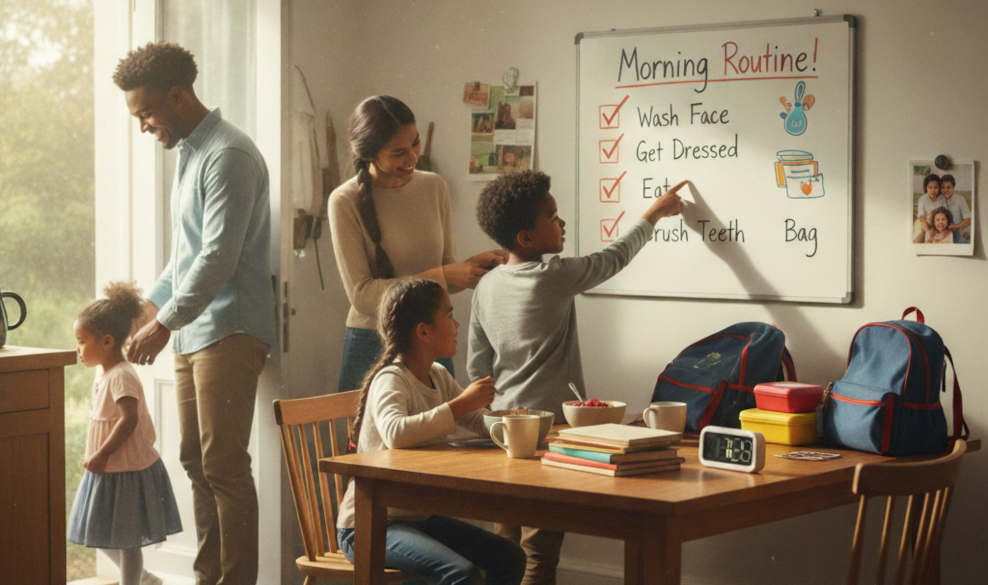The Power of Routines
Life with children is busy, beautiful—and sometimes chaotic. Between school runs, mealtimes, work and bedtime, the day can easily spiral. But simple family routines can be a lifeline. When life feels predictable, children feel safe. Routines provide the rhythm that grounds your family, helping everyone feel calmer, more connected and more in control.
In this post, we’ll explore the power of simple family routines and how they can support your child’s emotional wellbeing, behaviour, and learning. We’ll also provide a practical, downloadable checklist to help you get started.
Why Routines Matter
Children thrive on structure. Whether your child is neurotypical or has additional needs, routines reduce anxiety by creating a sense of stability. They:
- Help children know what to expect
- Reduce arguments and decision fatigue
- Improve time management and independence
- Support transitions (e.g. home to school, holidays to term time)
- Build stronger family bonds
But routines don’t need to be rigid or complicated. The best routines are simple, flexible, and consistent.
Keeping It Practical
The key to successful routines is keeping them practical and achievable. You don’t need colour-coded charts or military precision—just consistent, repeatable steps that suit your family.
Here are some tips:
- Start small: One routine at a time is fine
- Involve your child in planning to build ownership
- Keep instructions simple and visual if needed
- Use timers, music, or stories to mark transitions
- Stay flexible: it’s okay if things don’t go to plan
Remember, the aim isn’t perfection—it’s predictability.
Morning and Bedtime Routines
These are often the trickiest parts of the day, especially during the school week. But when done well, they set the tone and help avoid stress.
Morning Routine Tips:
- Prepare as much as possible the night before (clothes, bags, lunch)
- Use a visual checklist or whiteboard to list steps: wash face, get dressed, eat breakfast, brush teeth
- Allow time for calm connection—five minutes of cuddles can go a long way
Bedtime Routine Tips:
- Follow a consistent wind-down: bath, pyjamas, quiet story or music
- Avoid screens for at least 30 minutes beforehand
- Use low lighting and soft voices to signal sleep time
- Let children know what’s happening the next day—it reduces anxiety
A peaceful bedtime helps children fall asleep more easily and stay asleep longer—something every parent appreciates. Read The Sleep Charity’s relaxation tips for more tips on helping children sleep.
Mealtimes
Family meals are about more than food—they’re a daily opportunity to connect. Even one shared meal a day can make a big difference.
Simple ideas:
- Keep mealtimes screen-free and relaxed
- Let children help with setting the table or clearing up
- Use mealtime to check in: “What made you smile today?”
- Be realistic—some meals will be messy or rushed, and that’s okay
Even small routines like a mealtime blessing, a ‘cheers’ or a favourite dinner-night can become grounding family traditions.
Holiday Preparation
Switching from term time to holidays—and back again—can be challenging. Routines help reduce anxiety, especially for children who struggle with change.
Before a holiday:
- Use a countdown or visual calendar
- Talk about what will stay the same (e.g., bedtime, meals)
- Pack together, letting your child choose one or two items
Before returning to school:
- Gradually bring bedtime forward over a few nights
- Reintroduce elements of the school routine (uniform, packed lunch)
- Have a practice school run if possible
Giving your child time to adjust can prevent overwhelm and boost confidence.
Balancing the School Week
The school week can be intense, especially for children with additional needs. A consistent routine at home helps them recharge and feel secure.
Top tips for a balanced week:
- Create space for rest and downtime—not every minute needs to be filled
- Have a regular homework slot, but keep it short and focused
- Limit after-school activities if your child is easily overwhelmed
- Build in calming rituals after school—quiet play, a snack, or a cuddle
The aim is to create a rhythm that balances learning with rest, without overloading your child or yourself.
Simple Family Routines Checklist
Family life often feels busy and unpredictable, but simple routines can create a sense of calm, connection and confidence for everyone. By setting consistent rhythms around mornings, bedtimes, mealtimes and the school week, children know what to expect and parents can enjoy smoother days. This checklist is designed to be practical and adaptable; choose the ideas that work for your family and use them to build supportive daily habits.
🌞 Morning routine
☑ Wake up at consistent time
☑ Use a visual or written checklist
☑ Wash face / brush teeth
☑ Get dressed (clothes ready the night before)
☑ Eat a balanced breakfast
☑ Pack school bag / check essentials
☑ Five-minute cuddle or calm moment before leaving
🌙 Bedtime routine
☑ Start wind-down at consistent time
☑ Bath or shower
☑ Pyjamas on
☑ Quiet story, music, or chat
☑ No screens 30–60 minutes before bed
☑ Discuss plans for tomorrow
☑ Bedtime hug / say goodnight
🍽️ Mealtimes
☑ At least one shared meal daily
☑ Encourage calm, screen-free table
☑ Let children help set/clear table
☑ Ask open-ended questions (e.g. “What made you smile today?”)
☑ Include a small ritual (e.g. ‘cheers’, candle, blessing)
🏫 After-school balance
☑ Regular after-school wind-down time
☑ Light snack and quiet activity
☑ Homework slot (short and focused)
☑ Limit to 1–2 weekly activities (if needed)
☑ Family time at least once mid-week
☑ Calming bedtime routine
Final Thoughts
Routines aren’t about control—they’re about creating comfort, confidence, and connection. In a world that can feel unpredictable, especially for children, simple routines offer security.
Whether it’s brushing teeth after breakfast, Friday night pizza, or a goodbye hug at the school gate—these small, repeated moments are powerful.
And remember, your routine doesn’t have to look like anyone else’s. Trust your instincts, keep it simple, and give it time.











